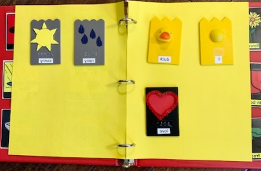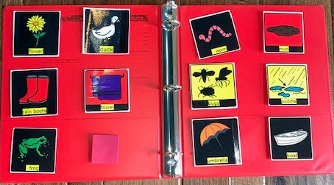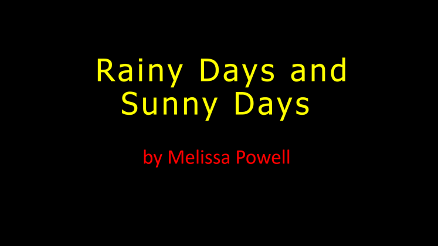Adapting "One Rainy Day" for Students with Visual Impairments

As part of the graduate coursework for Visual Impairments and Multiple Disabilities in the Teacher Preparation Program in Visual Impairments at the University of Kentucky, students were asked to complete four projects: a Story Box with at least 10 objects that correspond to the story, picture communication symbols and tactile communication symbols designed to go along with the story, and a talking book to go along with the story or represent concepts from the story.
We are sharing them on Paths to Literacy and hope that others will use them!
I choose the book, One Rainy Day, which was written by Tammi Salzano and illustrated by Hannah Wood, because it was appropriate for my preschool population and addressed vocabulary (nouns, verbs, adjectives) and was bright and simple. It also addressed colors/color words which would be important for students with low vision. The simplified nature of the story and images would be appropriate for students with both visual impairments and multiple disabilities.
Story Box
The book works well as a story box, as it is about rainy days, and it allows for extension lessons on weather, wet vs. dry, exploration, etc. The objects could be sorted by: living/non-living, size, function, soft/hard, etc.
I choose to use a small duck as it had the appropriate parts (duck, wings, bill, eyes, feet) that could be tactually explored. The texture, while not real feathers, is also similar to a baby duck (rather than a rubber duck). The worms are playdough, which can be rolled and formed by the student which could lead to conversations about sizes of real worms (vs. snakes, etc.). The flower is the size of a real flower and has individual petals that can be felt, as well as leaves. The mud (playdough) is cool and sticky. The washcloth is of a real size and cloth. I choose the boots as they are not only real and rubber, but are large enough to act as the storage box for the kit. The paper boat is like the ones in the book and students could make their own boat and actually float it in a pan of water. The umbrella is real and could lead to discussions about open/closed and over/under. The bugs I choose were realistic and, for the most part, appropriately sized
The story box will be used in one-on-one sessions with my preschool students. I plan to texturize and braille the book at a later date. The book will be read aloud to the student and we will hold, touch, and explore each item as we come to it in the book. I plan to imbed the concepts named above into the reading and exploration time. My picture symbols go with the items in the story box. I plan to use those at the end of the book for question/answers about the book and for choice making which items they may want to play with.
Tactile Symbols
As part of the ongoing project collection, I added 15 tactile symbols to the items that relate to a preschool-level book, One Rainy Day. I used the APH Tactile Connections picture symbols cards and created my own tactile cards to be used along with the story box, book, picture symbols, and talking book that were created as part of this kit. I chose to display/store these symbols in a binder that I had already created to store the accompanying picture symbols. The cards were attached with Velcro to yellow cardstock pages and organized by category.
I choose symbols in a variety of categories to enable my student(s) to have both object vocabulary related to the story, but also core vocabulary to be able to build conversation around not only the book but also expansion lessons.
The weather symbols (rainy and sunny)are the same symbols that each of my classrooms use during their morning meeting to do the daily weather and are already familiar to my students. The remaining symbols will require some pre-teaching and use across the student's daily routine to build meaning. I chose to use the Tactile Connections symbols for I, want, like, and play. I used the Texas School for the Blind symbols for open and love. I created the object symbols with items similar or much like the 3D objects that are in my story box.

Tactile symbols include:
People
- I: This card was added to enable the student to make requests and build sentence vocabulary such as, "I want…" or "I like…" by adding these to the object cards.
- Duck: I chose to use place this main character in the people category as he was the central figure in the book.
Actions
- Open: In order to create expansion lessons, I added a variety of action cards. For instance, open could be used to request that a tub of water be opened to allow water play with talking about the book page where duck splashes in a puddle.
- Play: The talking book that goes with this unit has things to do on a sunny vs. rainy day. The play card can be used to talk about play activities related to each type of day or to request play with the objects in the kit.
- Want: Can be used to make requests for items in the book or build a sentence such as, "I want water play."
- Like: Duck talks about things on a rainy day he likes. This card can be used to talk about things we like on sunny days, rainy days, or any day.
Expressions
- Love: In the book, Duck's momma dries him with a towel and tells him she loves him. This card can be used related to the story or to name people the student loves.
- Objects (colors of objects on the tactile cards remained true to color concepts named in book)
- Boots: Red vinyl paper was used to simulate the red rubber boots from the story kit and the book.
- Worm: A pipe cleaner was used to simulate the shape/size of the worms in the object kit.
- Umbrella: A small bit of the same fabric as the umbrella in the object kit was used as it would feel as similar as possible to the actual object.
- Towel: A small piece of the towel used in the object kit was used.
- Puddle: The same corrugated paper as is used for the rain drops on the rainy day card was chosen as my students already had prior knowledge of this card from classroom weather cards.
- Bug: The same bug used in the object kit was used.
Expansion
- Rainy: This card relates to the book, but can also be used for daily weather lessons or to answer questions.
- Sunny: Can also be used as related to daily weather or for giving a two-choice response field for questions such as, "Was it sunny or rainy in our story?" or "Which kind of day would be good for splashing in puddles?"
Picture Symbols
I choose to use BoardMaker symbols that closely resembled the items in my story box. I used simple lines and bright colors where possible. The background color for each picture was chosen to give contrast for CVI students, so red, yellow and black were used. I choose to use pictures that matched the 10 items in my story box as vocabulary building was the focus for my pre-K level book. I plan to use the pictures as a way for the students to answer questions related to the name or qualities of each object, as well as answer comprehension questions from the story itself. I will also use the pictures to enable the student to make requests for each item for play-time, such as floating the paper boats in a tub of water.
A small sample of comprehension questions/tasks:
- When Duck goes outside on a rainy day, what does he need to keep him dry?
- When Duck's momma needs to dry him off, what does she need?
- Which animal lives under the ground? Would you like to touch a worm-why or why not?
- Which one smelled good to duck on his walk? What time of year do we see flowers?
- Which animal makes a quacking sound? Do you think ducks quack when they are happy/scared/mad?
- Things that float ride on top of the water. Which item did duck float on the water? Could duck really ride in this kind of boat?

Talking Book Project
This is a talking book I created as an extension lesson for the book One Rainy Day. The original book was about a duck's adventures on a rainy day. I created this to extend it into a weather lesson on rainy vs. sunny day characteristics. I used simple pictures of limited complexity and used bright colors for my students who are visually impaired. The background color, black, was chosen for its high contrast. Font size is increased and was given contrast (yellow) for CVI students. The pages are recorded to give students with multiple disabilities access to the story and can be activated via switch if needed.

